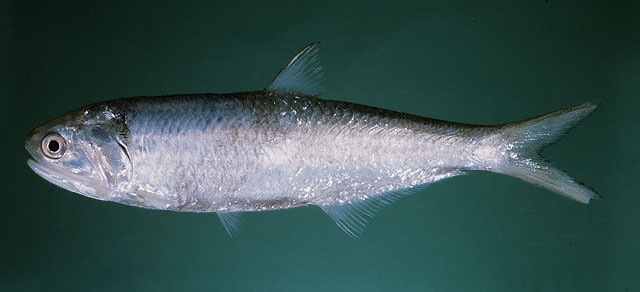|
Dorsal spines (total): 0-0; Dorsal soft rays (total): 13-14; Anal spines: 0-0; Anal soft rays: 34-44; Vertebrae: 43-45. Diagnosis: Body compressed, belly with 16-19 pre-pelvic and 8-12 post-pelvic scutes, a total of 24-30 keeled scutes from isthmus to anus; maxilla long, reaching beyond base of first pectoral finray; first supra-maxilla a minute oval; lower gillrakers 18-24, the serrae on the inner edge in distinct clumps in larger fishes; anal fin with 3-4 unbranched rays and 31-40 branched rays; a dark blotch behind upper part of gill opening; inside of gill cavity bright orange (Ref. 189). This species overlaps the range of different other species of Thryssa, of which five have a similar maxilla, very small first supra-maxilla and overlapping gillraker counts; however of these five species, T. gautamiensis, T. malabarica, T. purava and T. whiteheadi all have the tip of the snout at or above the level of the centre of the eye, and the last two, plus T. stenosoma, have at least 38 branched anal finrays (Ref. 189).
Description: Body fusiform, fairly strongly compressed, and its bluntly rounded, almost translucent snout distinctly overlaps the large, underslung mouth (Ref. 28, 189, 12484). Both jaws bear very fine teeth, and the upper jaw extends far back, but not beyond the pectoral fin base, as in the case of the similar, but more tropically distributed Thryssa setirostris (Ref. 12484). The 3 or more rakers on the first gill arch are long and serrated; 18-24 lower gillrakers and 14-17 upper gillrakers on first arch; branchiostegal rays 11-12 (Ref. 189, 5430, 12484, 30573, 122607). None of the fins have spines; dorsal fin with 3 unbranched and 10-11 branched rays; anal fin with 3-4 unbranched and 31-40 branched rays; pectoral fin with 1 unbranched and 11-12 branched rays; pelvic fin with 1 unbranched and 6-7 branched rays; caudal fin is strongly forked (Ref. 189, 5430, 12484, 122607). There are about 40-44 series of scales arranged along the lateral line (Ref. 5430, 12484). The scales along the underside, before and behind pelvic-fin base, are developed into 24-41 scutes which give the belly a sharply edged keel; usually with 16-19 pre-pelvic and 8-12 post-pelvic keeled scutes from isthmus to anus (Ref. 189, 5430, 12484). Vertebrae 43-45 (Ref. 122607).
Colouration: The overall body colour is silver, but the fish is usually bluish along its dorsal surface; the belly is white; the fins are translucent or dusky-yellow and the inside of the mouth is conspicuously orange (Ref. 12484). A dark blotch behind upper part of gill opening; inside of gill cavity bright orange (Ref. 28, 189, 30573). |
| A coastal, pelagic species (Ref. 28), apparently common along shore and in estuaries (Ref. 5430). Presumably schooling, occurring inshore and entering estuaries and lagoons, perhaps used as nursery areas, but moving further out in rainy seasons when coastal waters are freshened up by rivers (Ref. 189). It feeds on plankton organisms (Ref. 28). May be caught using ringnets (Ref. 5213). Generally marketed fresh, may be salted or dried (Ref. 5284). |
